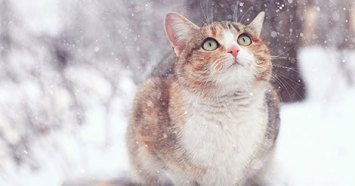
The modern-day domestic house cat is actually a descendant of wild desert cats. This could explain why cats in general are heat seekers and tend to snuggle up in the warmest place possible. But how cold is too cold for your cat? Do cats get cold easily? The exact answer to this question is difficult and depends on many factors. For cats, temperature tolerance (i.e., at what point a cat gets cold) can vary quite a bit depending on body weight, age, hair coat, and breed. For example, thin cats with short hair are going to get colder much more quickly than robust, long-haired cats. While exact temperatures are unclear, the American Veterinary Medical Association (AVMA) recommends that the ambient temperature remain above 50°F (and below 80°F) for animals in sheltered housing. Another good way to judge if the temperature is appropriate for your cat is to gauge how you feel. If you are cold, your cat is probably cold too.
Is my cat too cold?
Cats' primary responses to being cold are to conserve heat, such as curling up, and to generate warmth, such as shivering. If a cat becomes too cold, he may develop hypothermia. This occurs when his body temperature drops below normal (<99°F) and occurs because he is losing more heat than he can generate. Hypothermia can happen if a cat spends prolonged periods of time in cold and/or wet environments. There are multiple ways to spot hypothermia, some symptoms include:
Slowed breathing
Cold, clammy skin
Sluggish and uncoordinated movements
Inability to respond normally to stimulation
If you think your cat has developed hypothermia, you should call your veterinarian immediately. Take his temperature rectally to determine how low his body temperature is. If your cat is wet, make efforts to dry him off to prevent him from losing any more body heat. Begin efforts to rewarm your cat slowly and do not directly apply heat (i.e., don’t use a heating pad). An example of a safe way to rewarm your cat is to put towels in the dryer and then place him in the warm towels. Some cats with hypothermia will also have low blood sugar. If your cat is awake and aware enough to swallow, offer him a small amount of Karo syrup or some other form of calorie dense paste (e.g., Nutrical). Take your cat to the veterinarian’s office as soon as possible so they can continue to care for him further.
What to Do For Outdoor Cats When it Gets Cold
Some cats do not have homes or cannot be prevented from going outside. Due to a cat’s fluctuating temperature tolerance, it is important to provide feral cats with a place to keep warm that is sheltered from environmental elements such as rain, snow, and wind. Ideally, this shelter would have a roof, adequate ventilation, and appropriate insulation to keep a cat warm. Blankets or straw bedding can provide additional insulation to the area. Be wary of using heating pads because they can quickly burn a cat’s thin and sensitive skin. Provide food and water near or inside the shelter – staying warm requires extra calories. Monitor the water source to make sure it does not freeze.